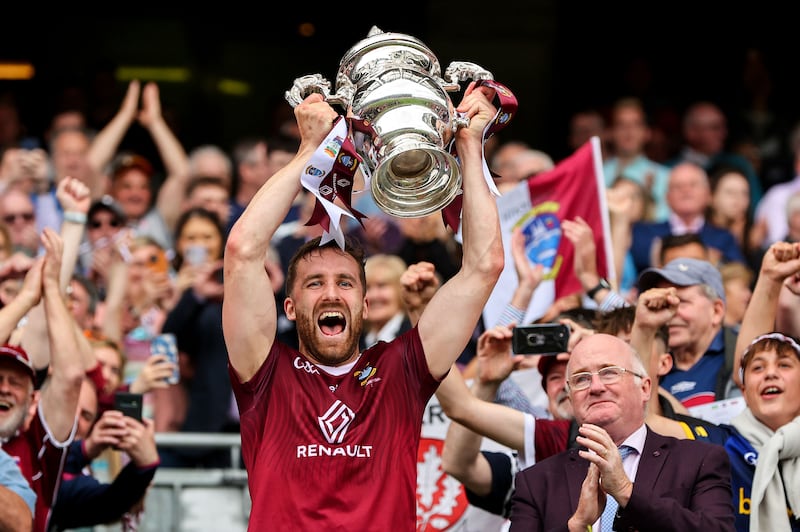The Tailteann Cup could have done without this turning into a Liveline week. Out of nowhere, the GAA found itself wheel-spinning in one of the three times in a year where owl’ lads talk to Joe. Next thing they knew, Micheál Martin was chancing his arm and the RTÉ Head of Sport was getting a shoeing on the Six-One. In the maw of all that, you may as well be screaming at the sea as trying to get people jiggy about the second-tier football championship.
By rights, of course, our national sport for the week ought to have been asking the Government had they nothing better to be at. Lads, how about ye go and build some houses or the odd hospital or maybe organise it so that people don’t need to take out a credit union loan to fill a grocery trolley? Can you do some of that please before you start wanging on about whether or not people should have to pay for matches THAT THEY’VE BEEN PAYING FOR FOR ALMOST A DECADE AT THIS STAGE! CAN YOU DO THAT?!
Ahem. Anyway, the Tailteann Cup. The whole week didn’t start well, it has to be said. The Tailteann Cup was just sitting there minding its own business when Dónal Óg Cusack launched into his Ezekiel 25:17 routine on last week’s Sunday Game. Somewhere along the way, an impassioned call to get more hurling on to RTÉ veered off into a side street and performed a gratuitous drive-by on the unsuspecting, innocent bystander Tailteann Cup. What did it ever do to anybody?
He noticed the TV coverage of last year’s Tailteann Cup semi-final was shot from the Cusack Stand to make it look like there was a crowd at the game. “Someone had the back of Gaelic football,” he said. “If someone had the back of hurling in that same way ...” A perfectly reasonable point, in fairness.
‘There’s no control in games anymore’: Darragh Ó Sé, Dean Rock and Conor McManus chat about the 2025 All-Ireland
Cork could confirm their rise by blasting their way past Tipperary
Laois dominate Wexford in opening round of Leinster SFC
Munster SFC: Cork book semi-final showdown with Kerry after easy win over Limerick
But by the end of the week, he’d clearly decided he’d been altogether too level-headed on the telly. In his Morning Ireland radio address yesterday, Dónal Óg went back for another slice. “The GAA schedule has two provincial football finals and the start of the Tailteann Cup, which if you haven’t heard of it, is a sort of Gaelic football Grand National for disappointed also-rans.”
Ah here. Let’s walk easy a while, Comrade Cusack. You ain’t got no quarrel with the Tailteann Cup. You’re launching missiles into the Black Sea when Moscow’s thataway. You won’t save hurling with Pound-Shop Brollyisms about a thoroughly inoffensive football competition.
Now, the Tailteann Cup isn’t going to rise or fall on the back of hurling pundits taking it as a sign of the apocalypse. But it doesn’t need that sort of casual, offhand dismissal either. This is particularly true as it heads into its second season and attempts to build on the various successes of the first.

Everyone who is invested in the competition knows the worth of the impending couple of months. The first year went off broadly without a hitch. Pretty much every team sent out its full squad. None of the managers badmouthed it. There was no large-scale exodus to the States to speak of. The games came and went, the final threw up not just a mild surprise but also a grandstand finish. The winners revelled in their triumph.
Crucially, the matches were mostly close. The 2022 Tailteann Cup had 16 games, of which eight were decided by a goal or less. For comparison, the 2022 All-Ireland series had 15 games, only four of which were decided by a goal or less. There was only one double-figure victory in the Tailteann Cup, compared to three in the Sam Maguire.
None of this proves anything – the sample size is too small after just one season. But it does at least point to the general usefulness of having teams of relatively equal ability play against each other. Anyone who wants the Tailteann Cup to succeed will hope that trend continues this time around, over an extended 35 matches.
There is a subtle but crucial difference between the Tailteann Cup and its hurling analogue, the Joe McDonagh. The majority of the teams in the Tailteann would see themselves as representing football counties. Whereas very few of the Joe McDonagh teams would say they came from hurling counties.
To take this year’s iteration, Offaly is a properly dual county. But Carlow, Kerry, Laois, Kildare and Down are football counties with pockets of hurling in them. Those pockets are of varying sizes but pockets they are. The local gardaí don’t generally need to prepare much of an action plan to cope with a Joe McDonagh homecoming.
Whereas with the Tailteann Cup, the pubs of Mullingar saw their best night of the summer last July. Winning the competition meant something genuine, not just to the Westmeath team but to their people. Forget formats, forget qualification criteria, forget all the nuts and bolts of the thing – that’s going to be the determining factor in whether or not the Tailteann kicks on and beds in for the long haul.
None of the big hurling counties ever have to give the Joe McDonagh a second glance. It means nothing to them because they’ll never be in it. But football has a virtually endless middle and all but five or six teams will have cause to look over their shoulder at the Tailteann in the next few seasons. Kildare only avoided it by one place this year. Ditto Cork last year.
That’s no bad thing, either. Given a fair wind, the Tailteann Cup will become the competition that the overwhelming majority of counties end up taking a swing at over the next decade. It will certainly have a far wider variety of contenders in a given year than the Sam Maguire. A settled 2023 season will go a long way to making it a fixture in the landscape. Maybe even worthy of a Liveline hour itself one day.
God knows they’ve made meals out of thinner gruel in their time.














